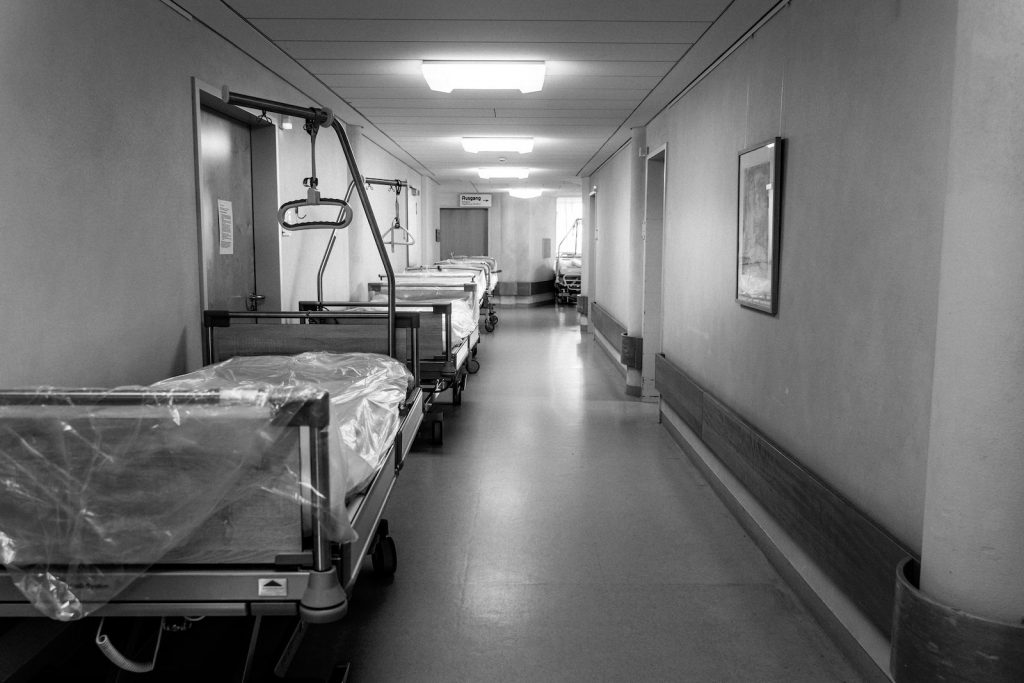Bed-ridden patients lined the hallway, some gasping for their last breaths. This was a day in December, during the post-Thanksgiving spike of COVID-19 infections, at a hospital in Los Angeles near Skid Row. The rooms were full, so a hallway had been converted to an ICU, stuffed with nursing stations, boxes of protective equipment, and dying patients.
Nat De Luca, a chaplain at the hospital, remembers the Code Blue alarms announcing medical emergencies. On a normal day, he might hear it bleat three or four times. On this day, De Luca lost count around fifteen. The chaplain spent his whole shift meeting with patients’ families, suiting them with PPE and leading them to their beloved’s bedside to say final farewells. “Death kept occurring in that little hallway,” he said, “over and over and over again.”
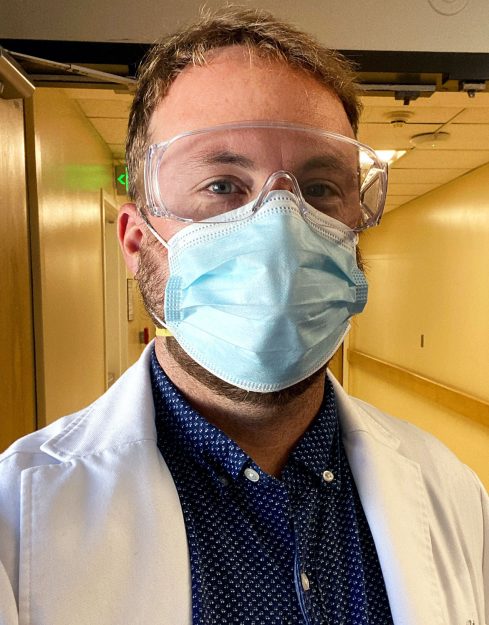
De Luca had biked to work from Venice Beach, where he shares a home with his husband. The 40-year-old chaplain, who practices in the Plum Village tradition of Vietnamese Zen master Thich Nhat Hanh, said life in Venice Beach was relatively normal, all pandemic things considered. People biked outside, walked their dogs. But just a few miles away, large numbers of people were suffering.
“It was like going to war every day,” De Luca said.
As pandemic grinds into its second year, the grim death toll continues to rise, even with new vaccines providing some relief. More than half a million Americans, and millions more around the world, have died after contracting COVID-19. The numbers are hard to grasp, especially because so many deaths occurred in hospital wards and nursing homes, where we can’t see or hear the dying.
But Buddhist healthcare chaplains do. They see refrigerator trucks filled with bodies parked outside hospitals. They see nurses, masks soaked with tears, holding patients’ hands so they don’t die alone. They hear families crying goodbyes on iPads and protesting hospital visiting restrictions. They witness exhaustion and death everywhere. Some chaplains compare what they’ve seen to Tibetan charnel grounds, a bardo, or the Buddha’s famous chariot ride, when he first encountered old age, sickness, and death.
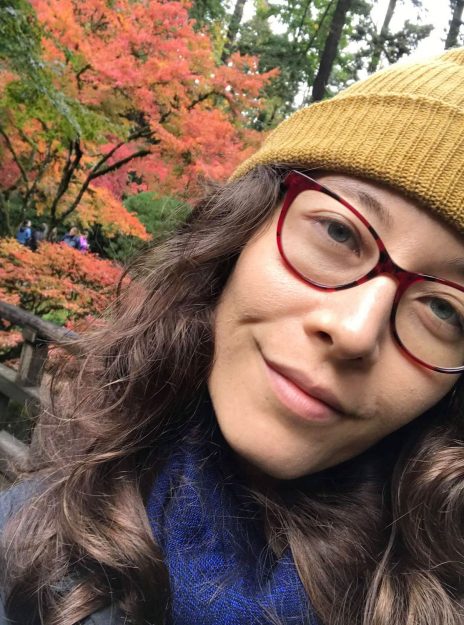
“The role of chaplain invites me into a direct encounter with the first noble truth,” said Holly Hisamoto, who was a hospice chaplain until recently, when she became a college advisor in Oregon. “It calls me into a relationship with suffering that is not intellectual and not heady and not removed by my desire for comfort.”
After witnessing traumatic deaths, Hisamoto, who was raised in Alaska, was drawn to care for people who suffered from similar psychic wounds.
But her mission, like everything else, was made more difficult by COVID. Even small decisions have huge consequences. One day, Hisamoto dressed in full protective equipment and drove to a nursing home, where she had planned to visit a resident. But the nursing home wasn’t allowing chaplains, leading to a moral quandary.
“Do I try to push my way in and potentially expose myself and others?” Hisamoto thought. “Or do I wait and waste valuable and scarce protective equipment? Just the weight of the responsibility to navigate all the moral repercussions, as well as my own fear of getting sick and dying, was a source of deep moral distress.”
Elaine Yuen has spent years thinking about Buddhist chaplaincy. For 12 years, she served as a hospital chaplain at Thomas Jefferson Hospital in Philadelphia, where she was also a researcher. A former professor at Naropa University, Yuen is part of a Harvard-funded team trying to map contemporary Buddhist chaplains.
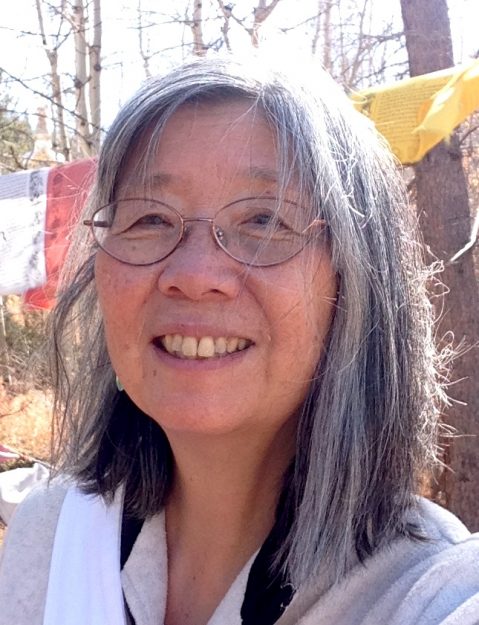
Yuen considers chaplaincy a creative endeavor, drawing on the Buddha’s example. “He saw the sick, the dying and a corpse—and sought to make meaning from that. Anyone who goes into chaplaincy works in that space: helping people make meaning from their suffering.”
That’s not to say Buddhist chaplains make their rounds while citing sutras or delivering discourses on the dharmic view of death. Most patients in the United States, after all, are not Buddhist. If the patient is Christian or Jewish, Buddhist chaplains may pray with them and try to provide spiritual resources from those traditions. But more often they practice a ministry of presence. They hold patients’ hands, linger in nurses’ stations, huddle with distressed staffers for emotional breaks. They help grieving and anxious families through painful end of life decisions.
Many of the most serious COVID patients are sedated and intubated, so they can’t talk. Others can talk, but it’s hard to hear voices through the layers of masks, the whir of breathing machines, and the hospital din. Sometimes, non-verbal forms of communicating are required.
“I keep my eyes connected with theirs and nod a lot,” said the Rev. Tenku Ruff, a Soto Zen priest and chaplain of a hospital in Tarrytown, New York. “And I rely on my Buddhist training to connect beyond words and letters.”
Caring for patients is only part of the chaplain’s ministry. During the pandemic, many say they’ve spent an equal amount of time attending to overwhelmed doctors, nurses and other healthcare workers, many of whom have felt helpless against the disease, especially early in the pandemic. “They have been exposed to so much trauma for such a long time,” said Laura Salazar-Hopps, a palliative care chaplain in Houston. Many are now experiencing trauma themselves.
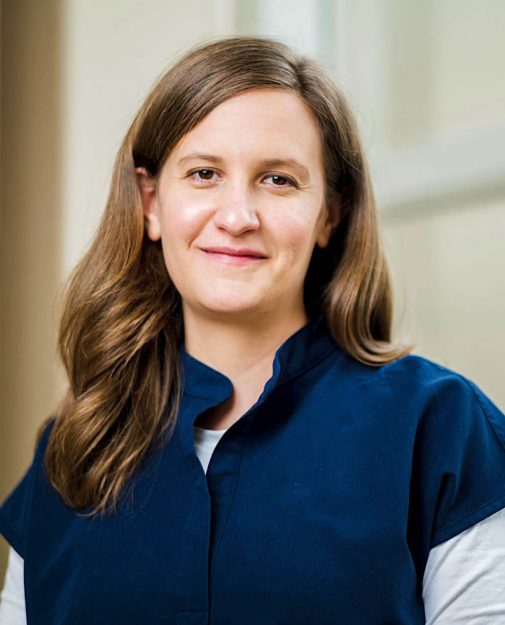
The deadly ice storm that rolled through Texas in February kept nurses and doctors away from their family or huddled with loved ones in freezing homes for days. Pushed to the edge of burnout already, healthcare workers were distressed by Texas Governor Greg Abbott’s recent decision to lift state mask mandates. Salazar-Hopps called it a “betrayal of healthcare staff as well as the entire state of Texas.”
Salazar-Hopps, who had a baby boy in November, said she tries to give hospital workers short meditations and practices to help them through long, draining days. That may be walking meditation, mindfully washing their hands or taking a moment to rest and reset before meeting a new patient. She recently instructed new nurses on how to be present with someone who is dying, while also practicing self-care. “I’m really trying to find anything that can help.”
The chaplain said her interest in Buddhism began when she found a book by Thich Nhat Hanh left behind by a Christian missionary in Nicaragua, where she volunteered. After studying at Harvard Divinity School, Salazar-Hopps practices with the Natural Dharma Fellowship.
Wearing a mask and social distancing is a form of practice, she said, a benefit for the whole community. “We are deeply interconnected. We are tired, but we need to continue wearing masks and social distancing.”
Before becoming a hospital chaplain in Toronto, Jeff Braff was an epidemiologist for forty years, where he worked on infectious diseases. But Western medicine’s approach to dying seemed to be overly fixated on one thing—delaying death—even when that might not be the best option, he said.
So in 2015, Braff, 72, moved from California to Dharamsala, India, where he studied and was ordained by Tibetan monks and took the dharma name Ven. Lobsang Yonten. At first, his teachers didn’t understand why he wanted to be a hospital chaplain, Braff said, until he explained that most Americans die in hospitals. And, he explained, in the Tibetan Buddhist tradition, death is the most important moment in a person’s life.
“You don’t have to live in a monastery to live the dharma,” Braff said. “I wanted to make a difference in people’s lives by how they died.”
Nights and weekends find Braff making his rounds at St. Michael’s hospital. Even with the vaccines, he said, COVID-19 will not go away. “You feel it when you walk into the ward, that this is something we’re going to have to deal with for a while. And there is always going to be something worse coming.”
When, amid the pandemic, wildfires hit California, it felt so unreal—one crisis on top of another—that it was difficult to process, said Holly Hisamoto. With the state looking like a hellscape, she concentrated on providing an emotional anchor for others.
One day, one of her lamas, who had retired, called and asked her to visit. As she sat in his backyard, she expected to hear advice or guidance on her practice. Instead, the lama listened.
“He just acknowledged the enormity of what I was doing every day,” Hisamoto said. In the days that followed, she felt nourished and uplifted in a way she cannot explain.
“Just for him to say, ‘I see you, and I am here for you’—it was the most powerful thing.”
Thank you for subscribing to Tricycle! As a nonprofit, we depend on readers like you to keep Buddhist teachings and practices widely available.
